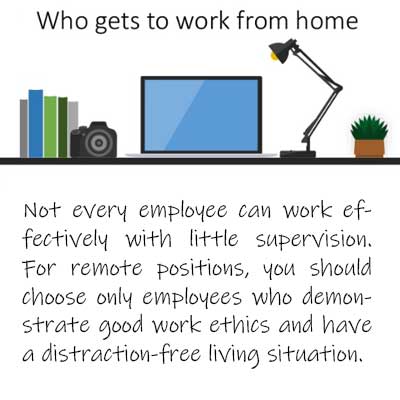Best Policy on Work from Home
 Fully remote jobs and work from home policies are on the rise, particularly in the tech industry. Typically embraced for its flexibility, remote work has been made possible by mobile devices and cloud-based applications. Now that people are able to conduct the same work at home, motivation for coming into the office has plummeted.
Fully remote jobs and work from home policies are on the rise, particularly in the tech industry. Typically embraced for its flexibility, remote work has been made possible by mobile devices and cloud-based applications. Now that people are able to conduct the same work at home, motivation for coming into the office has plummeted.
It’s good for employers too as it reduces employer expenses.
Most traditionally-staffed organizations begin by allowing employees to test remote working with part time to test the waters. But eventually, this will lead to an “Uber-ization” of the workforce, with more people shifting to full-time remote positions.
But you can’t just send remote workers to the wolves. A company needs a defined work from home policy to make it work.
A remote work policy should offer a window into the remote employee’s workday so that you can feel comfortable about productivity. Below, you’ll find some of the important factors to consider as you develop a work from home policy.
1. Decide Who Can Work From Home
Not every employee can work effectively with little supervision. For remote positions, you should choose only employees who demonstrate good work ethics and have a distraction-free living situation. Employees who want to work remotely need to be organized, disciplined, and self-motivated. Their position also needs to be suitable for remote work.
Employees who work from home should have job duties that don’t require a physical presence at the office.
2. Define Expectations
Be sure to set clear expectations for all remote workers. For some employees, you may have to do this on a daily basis.
Expectations include the hours they put in and communication via instant messaging, video chat, or phone. Inform employees of meeting schedules and always be available for communications, priorities, and updates.
Set expectations for the quality and output of every employee’s work. Identify the attitude and skills that will enable remote employees to perform work to your standards. To ensure remote employees stay busy, set reasonable deadlines or quotas wherever possible.
3. Choose Means of Communication
Effective communication is one of the biggest challenges in managing virtual employees.
Since remote workers are only reachable by digital means, they might miss important messages when they’re engrossed in a task or dealing with connectivity issues. Instead of relying on textual exchanges, there should be multiple forms of communication in place.
Encourage remote workers to keep their phones charged and close at hand, and to attend regular meetings via video conferencing software.
Remote employees also need to understand that phone calls, emails, and meetings still have to be part of their work day just as they are in the company offices. Without open communication, collaboration and work relationships become difficult.
4. Ensure Data and Device Security
One concern with a telecommuting workforce is digital security. Employees using their own devices may inadvertently introduce viruses to the company network. Even if you supply the device, they might still be tempted to download files or apps from home that have hidden malware.
Your IT team should ensure that every device that accesses your network has sufficient levels of protection in place. This includes firewalls, anti-virus software, encryption, and other forms of software protection both on each user’s device and your servers.
Make certain to educate remote employees on basic security policies. This includes things like secure passwords, logging off when away from their devices, and avoiding public WiFi.
Public WiFi is insecure and can compromise the safety of corporate data. Consider using a VPN (virtual private network) to ensure a secure channel for remote workers who like to work from a coffee shop.
You should also install remote-wipe solutions. This way, you can erase the hard drives of any lost or stolen device.
5. Clarify What Expenses You’re Going to Cover
While remote employees save on gasoline and other costs associated with the daily commute, they have higher expenses at home. High speed internet, phone, electricity and other utilities, and office supplies may offset the money they save in mileage.
You may want to establish a virtual employee allowance or reimbursement for these things.
Your business definitely should pay for or provide for free any software you require of them for security or productivity reasons. Be sure to clarify in writing all expenses and limits you’ll provide to remote workers.
You could also make provisions for updates, replacements, or processes for requesting additional funds. Have employees sign their consent before they start working from home.
Summary
Telecommuting can be a competitive advantage. However, you need to establish who can work from home as well as provide effective technologies for cyber security and communications. Be clear on your expectations for performance and which expenses you intend to cover. With a work from home policy working smoothly, both the company and your employees will be happier.

Aparna Sharma | Senior HR Professional & Certified Corporate Director I Editor’s Collection


